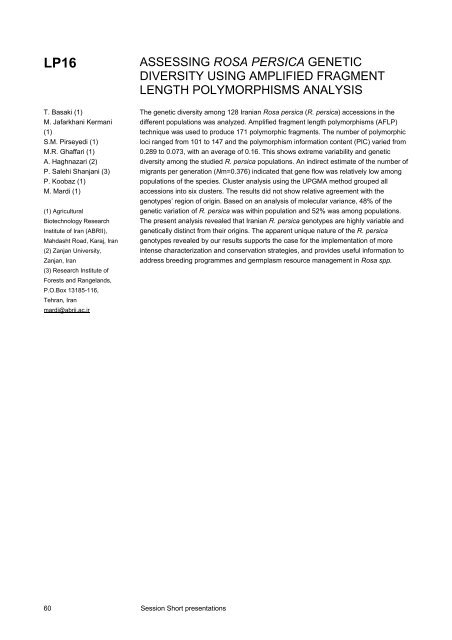XXIIIrd International Eucarpia symposium, Section Ornamentals ...
XXIIIrd International Eucarpia symposium, Section Ornamentals ...
XXIIIrd International Eucarpia symposium, Section Ornamentals ...
You also want an ePaper? Increase the reach of your titles
YUMPU automatically turns print PDFs into web optimized ePapers that Google loves.
LP16<br />
T. Basaki (1)<br />
M. Jafarkhani Kermani<br />
(1)<br />
S.M. Pirseyedi (1)<br />
M.R. Ghaffari (1)<br />
A. Haghnazari (2)<br />
P. Salehi Shanjani (3)<br />
P. Koobaz (1)<br />
M. Mardi (1)<br />
(1) Agricultural<br />
Biotechnology Research<br />
Institute of Iran (ABRII),<br />
Mahdasht Road, Karaj, Iran<br />
(2) Zanjan University,<br />
Zanjan, Iran<br />
(3) Research Institute of<br />
Forests and Rangelands,<br />
P.O.Box 13185-116,<br />
Tehran, Iran<br />
mardi@abrii.ac.ir<br />
ASSESSING ROSA PERSICA GENETIC<br />
DIVERSITY USING AMPLIFIED FRAGMENT<br />
LENGTH POLYMORPHISMS ANALYSIS<br />
The genetic diversity among 128 Iranian Rosa persica (R. persica) accessions in the<br />
different populations was analyzed. Amplified fragment length polymorphisms (AFLP)<br />
technique was used to produce 171 polymorphic fragments. The number of polymorphic<br />
loci ranged from 101 to 147 and the polymorphism information content (PIC) varied from<br />
0.289 to 0.073, with an average of 0.16. This shows extreme variability and genetic<br />
diversity among the studied R. persica populations. An indirect estimate of the number of<br />
migrants per generation (Nm=0.376) indicated that gene flow was relatively low among<br />
populations of the species. Cluster analysis using the UPGMA method grouped all<br />
accessions into six clusters. The results did not show relative agreement with the<br />
genotypes’ region of origin. Based on an analysis of molecular variance, 48% of the<br />
genetic variation of R. persica was within population and 52% was among populations.<br />
The present analysis revealed that Iranian R. persica genotypes are highly variable and<br />
genetically distinct from their origins. The apparent unique nature of the R. persica<br />
genotypes revealed by our results supports the case for the implementation of more<br />
intense characterization and conservation strategies, and provides useful information to<br />
address breeding programmes and germplasm resource management in Rosa spp.<br />
60 Session Short presentations














